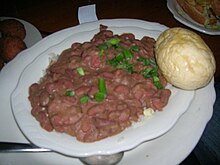food.wikisort.org - Dish
Red beans and rice is an emblematic dish of Louisiana Creole cuisine (not originally of Cajun cuisine) traditionally made on Mondays with Kidney beans,[1] vegetables (bell pepper, onion, and celery), spices (thyme, cayenne pepper, and bay leaf) and pork bones as left over from Sunday dinner, cooked together slowly in a pot and served over rice.[2] Meats such as ham, sausage (most commonly andouille), and tasso ham are also frequently used in the dish. The dish is customary – ham was traditionally a Sunday meal and Monday was washday. A pot of beans could sit on the stove and simmer while the women were busy scrubbing clothes. The dish is now fairly common throughout the Southeast. Similar dishes are common in Latin American cuisine, including moros y cristianos, gallo pinto and feijoada.
| Place of origin | United States |
|---|---|
| Region or state | Louisiana |
| Main ingredients | Red beans, rice, onions, celery, bell pepper, pork bones, spices |

When the Haitian Revolution ended and the First Empire of Haiti was established in 1804, thousands of refugees from the revolution, both whites and free people of color (affranchis or gens de couleur libres), fled to New Orleans, often bringing African slaves with them, doubling the city's population. They also introduced such Haitian specialties as the red beans and rice and Chayote (or called mirliton; a pear-shaped vegetable) to the Louisiana Creole cuisine.
Red beans and rice is one of the few New Orleans-style dishes to be commonly served both in people's homes and in restaurants. Many neighborhood restaurants and even schools continue to serve it as a Monday lunch or dinner special, usually with a side order of cornbread and either smoked sausage or a pork chop. While Monday washdays are largely a thing of the past, red beans remain a staple for large gatherings such as Super Bowl and Mardi Gras parties. Indeed, red beans and rice is very much part of the New Orleans identity. New Orleanian Louis Armstrong's favorite food was red beans and rice – the musician would sign letters "Red Beans and Ricely Yours, Louis Armstrong".[3] In 1965, the R&B instrumental group Booker T. & the M.G.'s wrote and recorded a song titled "Red Beans and Rice" that was originally a B-side but later became popular in its own right.
The similar vegetarian dish rajma chawal[4] (which translates literally to red beans and rice) is popular in North India. Red beans and rice is also a dietary staple in Central America, where it is known as arroz con habichuelas. The dish is popular in Cuban, Puerto Rican, Dominican, Haitian and Jamaican cuisine as well.[citation needed]
See also
- Cuisine of New Orleans
- Hoppin' John
- Rajma
- List of legume dishes
- List of regional dishes of the United States
- List of rice dishes
- List of sausage dishes
References
- South Louisiana red beans — Southern U.S. Cuisine
- Edge, John T., ed. (2014). "Red Beans and Rice". The New Encyclopedia of Southern Culture: Volume 7: Foodways. pp. 243–4. ISBN 978-1-4696-1652-0.
- Biro, Liz (February 27, 2007). "From New Orleans to India, red beans and rice has been a weekly tradition for years". Star-News.
- "Rajma Chawal". Famous India. Retrieved 2020-06-10.
External links
- Beans and Rice – Southern U.S. Cuisine
- New Orleans Red Beans and Rice – The Gumbo Pages
- How To Make Red Beans and Rice Video – Cookbook Man
На других языках
- [en] Red beans and rice
[es] Red beans and rice
Red beans and rice (en español ‘judías rojas y arroz’) es una receta emblemática de la cocina criolla de Luisiana (originalmente no cajún) hecha tradicionalmente los lunes con judías pintas, verduras (pimiento, cebolla y apio), especias (tomillo, pimienta roja y hoja de laurel) y huesos de cerdo sobrantes de la cena del domingo, cocido todo junto a fuego lento en una olla y servido sobre arroz. También se añade con frecuencia al plato carnes como jamón, salchicha (la mayoría de las veces andouille) o jamón Tasso. Es una costumbre antigua de la época en la que el jamón se consideraba una comida de domingo y el lunes se hacía la colada, resultando conveniente para las mujeres el poder dejar la olla al fuego mientras lavaban la ropa. Hay platos parecidos en la gastronomía de Latinoamérica, incluyendo los moros y cristianos y el gallopinto.Другой контент может иметь иную лицензию. Перед использованием материалов сайта WikiSort.org внимательно изучите правила лицензирования конкретных элементов наполнения сайта.
WikiSort.org - проект по пересортировке и дополнению контента Википедии
